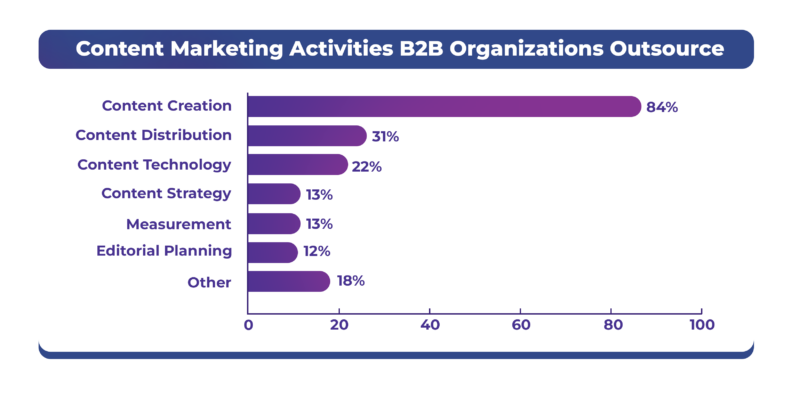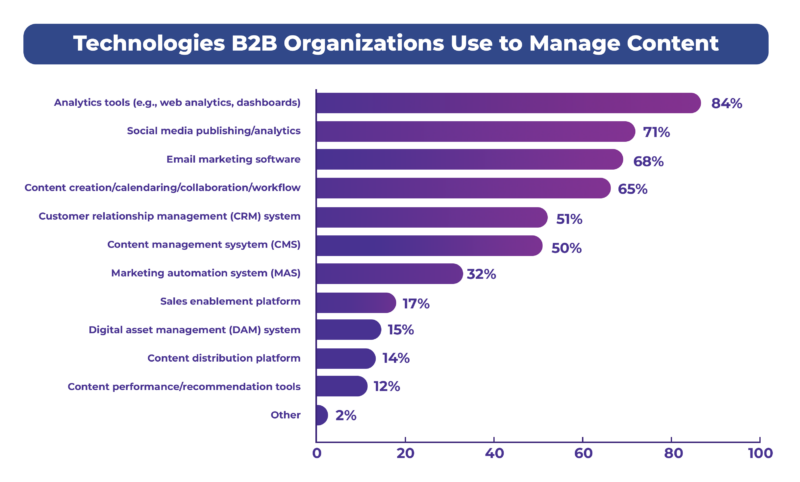B2B content marketing is a cornerstone of effective business growth and customer engagement. In today’s fast-paced business environment, however, producing high-quality and strategic content can overwhelm many businesses. This is why many are choosing to outsource content marketing tasks. Content outsourcing allows organizations to expand their content creation capabilities and allocate resources more efficiently. However, navigating the outsourcing process requires a well-planned strategy and awareness of the essential phases and considerations involved.
Whether you’re an experienced content marketer or just starting, this article will provide you with the knowledge and insights needed to harness the potential of outsourcing.

Benefits of Outsourcing B2B Content Marketing
Outsourcing B2B content marketing can provide various advantages to organizations looking to improve their digital marketing efforts. Here are a few significant benefits:
Cost Savings
Outsourcing content marketing eliminates many overhead expenses related to supporting an in-house marketing team. These expenses include salaries, benefits, office space, software licenses, equipment, and other operational expenses.
Many content marketing companies and freelancers have competitive pricing plans that can be more cost-effective than building an internal content marketing team. You can select from various pricing models, like fixed-price, hourly rates, or retainer agreements, to suit your budget.
Improved Customer Satisfaction
Content marketing professionals and agencies are experts in producing valuable, high-quality content that resonates with your target audience. They can develop a customized content marketing strategy based on your business goals and audience needs. You can benefit from their experience creating content that effectively educates and engages your customers.
Access to a Larger Pool of Talent
Content marketing agencies and freelancers offer a wealth of specialized knowledge, including graphic design, video production, SEO optimization, and content creation. This collective talent enables organizations to assemble a team with the skills needed for a particular content need, which is often challenging to achieve through a single in-house team. Outsourcing also provides access to industry-specific insights and a global perspective, making it easier to create content that resonates with target audiences while effectively addressing industry-specific trends and challenges.
Improved Efficiency
Entrusting content creation and marketing responsibilities to specialized agencies allows businesses to focus their internal resources and efforts on core activities and strategic priorities. This leads to better time management and productivity as content marketing experts are skilled in creating high-quality content, executing SEO strategies, and managing campaigns. With experts handling content-marketing tasks, companies can meet deadlines more efficiently and ensure their marketing initiatives remain consistent and on track.
Scalability
The content marketing needs of businesses often fluctuate due to seasonal variations, new product launches, or changing marketing strategies. Outsourcing enables businesses to easily scale their content production up or down as needed. Whether it’s the need to ramp up content creation during peak periods or scale down during slower seasons, content marketing service providers can respond quickly to these changes. This adaptability ensures that content remains aligned with evolving business goals and improves resource allocation, allowing companies to make the most efficient use of their budget.
Steps for Outsourcing B2B Content Marketing Effectively
Define your customer service needs
Outsourcing B2B content marketing effectively begins with thoroughly understanding customer service needs. Start by developing detailed buyer personas that reflect your target audience’s preferences, challenges, and content consumption habits. Set defined objectives for your content marketing initiatives, aligning them with the overall business goals. Identify the content types and channels most appealing to your target audience and the required content style and frequency. Furthermore, define your SEO plan, target keywords, as well as your budget, performance KPIs, and quality standards.
Research outsourcing options
Begin by identifying potential outsourcing partners, whether content marketing agencies, freelancers, or a combination. Make a list of potential candidates and evaluate them based on their skills, industry experience, track record, and portfolio of previous work. Consider their pricing models, scalability, and capacity to meet your content needs, such as blog entries, whitepapers, or video material. Assess their familiarity with your industry and target demographic and ability to adapt to your brand’s tone and voice. It is essential to check references and client feedback to determine their reliability and reputation.
Develop a clear communication plan
Establish regular communication channels and schedules with your outsourcing partner. Define roles and responsibilities, ensuring both parties understand their tasks and deadlines. To streamline the content creation process, implement a system for revisions and feedback and establish timelines for responses and issue resolution. Create a common repository for documents and resources to facilitate easy access to branding standards, content calendars, and other essential documents. Lastly, encourage open and transparent communication to foster collaboration and exchange of ideas.
Implement and monitor the outsourcing process
Implement the agreed-upon content strategy, ensuring that all content creation and distribution of tasks are completed as planned. Regularly communicate with your outsourcing partner to ensure alignment and quality, holding status meetings and providing feedback. Use project management tools to track progress and deadlines effectively. It is also essential to continuously assess content performance using relevant metrics and KPIs. To gauge the efficiency of the content, analyze website traffic, engagement rates, lead generation, and other critical factors. Make data-driven adjustments to optimize the strategy based on these insights, ensuring it remains aligned with your B2B marketing objectives.
Factors to Consider When Outsourcing B2B Content Marketing
When considering outsourcing B2B content marketing, several essential factors must be considered to ensure a successful collaboration and achieve your marketing goals:
Quality of Services
The quality of services your chosen service provider provides should be a top priority. Because the content you produce is a direct representation of your brand, quality is critical. Assess the outsourcing partner’s portfolio by looking at references and content samples to gauge the quality of their work. Specialization in B2B content marketing and related industries are critical indicators of their capacity to deliver high-quality content. Quality services include content development and a commitment to achieving your B2B content marketing goals efficiently and excellently.
Availability and Accessibility
It’s essential to ensure your outsourcing partner is available and accessible when needed. This includes considering their time zone and working hours, which should sync with your company’s operations to provide seamless communication and collaboration. Accessibility also includes their capacity to hold regular meetings, respond to emails, calls, and texts, and provide updates on project status. An effective working collaboration requires being accessible for urgent requests or addressing issues promptly.
Cost
Although outsourcing can be less expensive than keeping an in-house content team, it’s important to consider the financial aspects of the partnership thoroughly. Establish a clear budget and understand the outsourcing partner’s pricing structure. Assess how their prices fit your budget and the estimated return on investment (ROI). Consider whether the expense of outsourcing allows you to meet your content marketing objectives while staying within the budget. Choose carefully, as selecting the less expensive option does not always guarantee the best quality or outcomes. Instead, balance cost and the value the outsourcing partner can bring to your content marketing efforts.
Cultural Compatibility
Strong cultural compatibility facilitates productive collaboration by reducing misunderstandings, promoting open communication, and promoting a positive work environment. It is easier to communicate your brand’s messaging and maintain consistency in your content when you and your outsourcing partner share similar values and work ethics. It also helps problem-solving and decision-making, ensuring your content marketing approach aligns with your organization’s goals and values. Choosing a culturally compatible content marketing agency can lead to a more seamless and productive partnership, eventually improving the quality and effectiveness of your content marketing initiatives.
Tips for Successful B2B Content Marketing
Foster open and clear communication
Effective communication is critical for the success of any collaboration, and it is essential in content marketing, where ideas, feedback, and goals must be effectively communicated. Here are some tips to ensure open and clear communication in your marketing efforts:
- Establish clear communication channels, roles, and responsibilities with your internal and outsourced marketing team. Everyone should know how to contact each other and when to expect updates.
- Define clear guidelines for content creation, delivery timelines, and performance metrics.
- Be transparent about challenges, setbacks, and successes. Transparency fosters trust.
- Give constructive feedback on the content quality and performance and encourage your internal team or external partners to do the same. Use feedback as an opportunity to improve.
- Keep a record of critical discussions and decisions. This can help minimize misunderstandings and be a starting point for future content marketing projects.
- Actively listen to other’s input and ideas. Encourage brainstorming and discussion sessions to stimulate group creativity.
Maintain a consistent brand voice
A consistent brand voice strengthens your messaging, establishes your identity, and builds audience trust. Here are some steps to maintain a consistent brand voice:
- Define your brand voice and tone in your brand guidelines. Consider formal vs. informal, authoritative vs. approachable, and technical vs. conversational. Ensure it’s consistent with the target audience and industry.
- Provide training or workshops for your content creators and marketers to ensure everyone understands and can apply the brand guidelines.
- Create content templates for blog posts, whitepapers, and social media updates. These templates should include formatting, tone, and messaging to ensure consistency.
- Designate an editor to review content before publishing. They should check for alignment with brand voice, style guidelines, grammar, and accuracy.
- Establish a feedback mechanism for content review to correct any deviations from the brand voice promptly.
Use technology to your advantage

The digital realm provides a wealth of tools and resources that, when used effectively, can elevate content marketing. From content management systems that streamline content creation and distribution to analytics platforms that provide valuable insights, technology enables businesses to create engaging content and measure its impact. Below are ways to elevate B2B content marketing through technology:
- Use marketing automation tools like Hubspot, Marketo, or Pardot to automate repetitive tasks, nurture leads, and send customized content to your target audience.
- Use search engine optimization (SEO) optimization tools like SEMrush, Ahrefs, or Moz for keyword research. These tools help identify relevant keywords, track rankings, and optimize content for search engines.
- Utilize analytics tools to monitor website traffic, user activity, and content engagement. These can help make data-driven decisions and improve the content strategy.
- Explore with AI-powered content generation tools like GPT-3 to generate content ideas or automated responses. These resources can help save time and provide creative inspiration.
Continuously evaluate and improve the outsourcing process
- Set key performance indicators (KPIs) for your content marketing goals and track them regularly.
- Set up regular assessments to evaluate the performance of the outsourced partner. Assess their adherence to deadlines, work quality, and alignment with the marketing goals. Determine where improvements can be made.
- Promote a feedback-driven culture. Encourage the service provider to communicate openly and provide constructive feedback and suggestions on improving collaboration.
- Consider exploring alternate outsourcing models, such as on-demand freelancers, specialized agencies, or project-based partnerships, to determine whether they suit the changing content marketing needs.
Potential Challenges of Outsourcing B2B Content Marketing and How to Overcome Them
Language Barriers
Language barriers can be an issue when outsourcing B2B content marketing tasks, primarily if the outsourcing partner is located in a region where the primary language differs from the target audience’s language. It can lead to misunderstandings, resulting in content not aligning with your brand’s message. Language differences can also make it difficult to understand and incorporate cultural nuances essential for good content.
Strategies for Overcoming Language Barriers:
- Consider working with bilingual content creators who are fluent in the target language. They can bridge linguistic and cultural gaps.
- Provide detailed briefs containing specific guidelines, preferred vocabulary, and sample content consistent with your brand voice.
- Create a glossary of industry-specific terms and share it with the outsourcing partner to maintain consistency.
- If cultural nuances are critical, provide your outsourcing partner with training or materials on the target audience’s specific cultural context and preferences.
Time Differences
Dealing with time differences can be a significant challenge if the outsourcing partner is based in a different time zone. It can lead to communication delays, making it challenging to get timely responses to emails or messages. Finding meeting times suitable for both the internal and the outsourced content creators can be difficult, leading to delays in decision-making.
Strategies for Overcoming Time Differences:
- Clarify your expectations for communication channels and response times. Indicate the timeframe for responses and the urgency with which important issues should be handled.
- Implement shared calendars that show team member’s availability and working hours. This makes it easier to schedule meetings without exchanging several emails back and forth.
- Identify overlapping working hours between the internal and outsourced teams. Schedule important meetings and collaborative work during these hours to maximize real-time communication.
- Designate a team member or project manager responsible for managing time zone differences and coordinating schedules.
- Record meetings to accommodate team members who cannot join due to time differences. Make these recordings available for later review.
Maintaining Control Over the Customer Experience
When outsourcing B2B content marketing to an external agency, ensuring consistent branding and messaging across all platforms can be challenging as different writers or agencies may interpret your brand differently. Maintaining control over the quality of the outsourced content is essential to preserve customer experience. Poor quality content can harm the brand’s reputation.
Strategies for Maintaining Control Over Customer Experience
- Organize regular training sessions for your outsourced content partner to educate them on your brand, industry, and customer preferences. Make them an extension of your internal team.
- Establish a strict quality assurance process that includes content reviews, editing, and proofreading. Assign an individual from the in-house team or the outsourced partner to ensure the content meets the standards.
- Establish a feedback loop with the outsourced partner. Provide constructive feedback on content drafts and encourage them to seek input from the internal team to align with the goal.
- Implement an approval process before publishing the content. This helps ensure the content is consistent with the brand and customer experience.
- Monitor content performance metrics such as engagement, conversion rates, and audience feedback. Adjust your content strategy based on these findings to improve customer experience.
Outsourcing your content marketing is a strategic move that offers various advantages like cost savings, improved customer satisfaction, access to a larger talent pool, improved efficiency, and scalability. It is essential, however, to approach it with careful planning and execution. Factors like the quality of the provider’s services, availability, pricing model, and cultural compatibility are critical elements that must be considered when outsourcing. When executed effectively, businesses can harness the potential of outsourcing to drive the B2B content marketing strategy toward growth.



Leave A Comment
You must be logged in to post a comment.